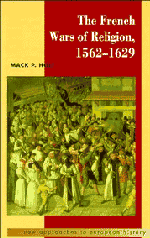Book contents
- Frontmatter
- Contents
- List of maps and figures
- Chronological table of events
- Introduction
- 1 Prologue: Gallicanism and reform in the sixteenth century
- 2 ‘The beginning of a tragedy’: the early wars of religion, 1562–1570
- 3 Popular disorder and religious tensions: the making of a massacre, 1570–1574
- 4 The rhetoric of resistance: the unmaking of the body politic, 1574–1584
- 5 ‘Godly warriors’: the crisis of the League, 1584–1593
- 6 Henry IV and the Edict of Nantes: the remaking of Gallicanism, 1593–1610
- 7 Epilogue: the last war of religion, 1610–1629
- 8 Conclusions: economic impact, social change, and absolutism
- Genealogical charts
- Brief biographies
- Suggestions for further reading
- Index
3 - Popular disorder and religious tensions: the making of a massacre, 1570–1574
Published online by Cambridge University Press: 05 June 2012
- Frontmatter
- Contents
- List of maps and figures
- Chronological table of events
- Introduction
- 1 Prologue: Gallicanism and reform in the sixteenth century
- 2 ‘The beginning of a tragedy’: the early wars of religion, 1562–1570
- 3 Popular disorder and religious tensions: the making of a massacre, 1570–1574
- 4 The rhetoric of resistance: the unmaking of the body politic, 1574–1584
- 5 ‘Godly warriors’: the crisis of the League, 1584–1593
- 6 Henry IV and the Edict of Nantes: the remaking of Gallicanism, 1593–1610
- 7 Epilogue: the last war of religion, 1610–1629
- 8 Conclusions: economic impact, social change, and absolutism
- Genealogical charts
- Brief biographies
- Suggestions for further reading
- Index
Summary
The Peace of St-Germain that concluded the third civil war in August 1570 promised much in the way of establishing a genuine and lasting peace. With legal provisions for enforcing the reintegration of the Huguenots back into the mainstream of French society introduced by the peace edict, with the Protestant queen of England seeking to strengthen ties with France with a possible marriage to one of the king's younger brothers, and with Catherine de Medici herself seeking to strengthen the bonds between the crown and the Huguenots by trying to arrange a marriage between her daughter Marguerite and the Protestant Henry of Navarre, the period following the conclusion of the third civil war offered hope that the calamities and horrors of war of the previous decade might be excised. Nevertheless, the diplomatic efforts of the political leadership to engender harmony with the Huguenots only heightened the fears of those Catholics throughout the kingdom, who had been raising the stakes of religious violence in the late 1560s. Thus, diplomatic efforts at court to create a lasting peace and restore order masked the further polarization of the Protestant and Catholic communities among the popular classes. At the same time, many Catholic nobles at court were becoming alarmed at the increasingly radical – and sometimes revolutionary – rhetoric of much Huguenot political polemic published since 1567. Overt suggestions that kings contracted their authority from ‘the people’ struck at the heart of the sacral foundations of the French monarchy and went a long way toward alienating many Catholic nobles further from any lasting peace.
- Type
- Chapter
- Information
- The French Wars of Religion, 1562–1629 , pp. 76 - 97Publisher: Cambridge University PressPrint publication year: 1995

